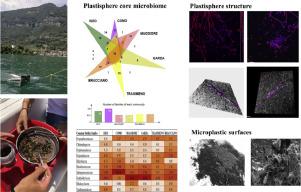Water Research ( IF 12.8 ) Pub Date : 2020-09-15 , DOI: 10.1016/j.watres.2020.116429 Francesca Di Pippo 1 , Cristina Venezia 1 , Maria Sighicelli 2 , Loris Pietrelli 2 , Stefania Di Vito 3 , Simone Nuglio 3 , Simona Rossetti 1

|
In this study, 16S rRNA gene high throughput sequencing and Fluorescence In Situ Hybridization (FISH) combined with confocal laser scanning microscopy (CLSM) were used to assess for the first time biodiversity and structure of microplastic-associated biofilms (plastisphere) collected from Italian lentic ecosystems. The analysis revealed clear differences in microbial community composition among biofilms and corresponding planktonic populations indicating a selective adhesion on microplastics (MP). Although geographical variations in taxa composition were observed, a plastisphere core microbiome, composed by known biofilm formers found in freshwater ecosystems (e.g. Sphingorhabdus, Sphingomonas, Rhodobacter, Aquabacterium and Acidovorax genera) was found. Species composition of plastisphere did not substantially differ between the diverse polymers, while a clear link with the MP exposure time was found by Fourier Transform Infrared spectroscopy (FT-IR) and Scanning Electron Microscopy (SEM) analysis. Generalist planktonic taxa (e.g. members of the families Sphingomonadaceae and Rhodobacteraceae) were found on MPs with the lowest degradation level whereas the biodiversity increased with the increase of MP degradation. FISH-CLSM analysis confirmed the Burkolderiaceae dominance in most of the analyzed plastisphere samples and revealed a patchy microbial colonization and a complex biofilm architecture with bacterial micro-colonies and cyanobacterial aggregates occurring together with microalgae assemblages.
中文翻译:

透镜状意大利生态系统中与塑料相关的生物膜。
在这项研究中,使用16S rRNA基因高通量测序和荧光原位杂交(FISH)结合共聚焦激光扫描显微镜(CLSM)来首次评估从意大利lentic收集的与微塑性相关的生物膜(质膜)的生物多样性和结构。生态系统。分析显示生物膜和相应的浮游生物种群之间的微生物群落组成存在明显差异,表明对微塑料(MP)的选择性粘附。尽管观察到了分类单元组成的地理差异,但由在淡水生态系统中发现的已知生物膜形成物(例如鞘氨醇单胞菌,鞘氨醇单胞菌,红细菌,水杆菌和嗜酸杆菌属)组成的质体层核心微生物组属)。各种聚合物之间的质体层物种组成没有实质性差异,而通过傅立叶变换红外光谱(FT-IR)和扫描电子显微镜(SEM)分析发现与MP暴露时间有明确的联系。在具有最低降解水平的MPs上发现了多面性的浮游类群(例如,Sphingomonadaceae科和Rhodobacteraceae科的成员),而随着MP降解的增加,生物多样性增加了。FISH-CLSM分析证实了大多数分析的质体层样品中Burkolderiaceae的优势,并揭示了片状微生物定植和复杂的生物膜结构,其中细菌微菌落和蓝藻聚集体与微藻组合一起出现。


























 京公网安备 11010802027423号
京公网安备 11010802027423号